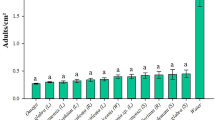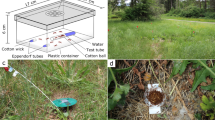Abstract
We tested the chemotactic response of infective juveniles (IJs) of the entomopathogenic nematodes (EPNs) Steinernema feltiae, S. kraussei, Heterorhabditis bacteriophora, and S. carpocapsae, to the synthetic volatiles (dimethyl sulfide [DMS], dimethyl disulfide [DMDS], dimethyl trisulfide [DMTS], allyl isothiocyanate [AITC], phenylethyl isothiocyanate [PITC], and benzonitrile [BN]) typically emitted by insect-damaged Brassica nigra roots. We hypothesized that attraction behavior exhibited by the EPNs toward the tested volatile compounds (VOCs) could be related to the species and would vary with foraging strategy, VOC, time of exposure and temperature. Steinernema kraussei was the most mobile species in our assay, and at 20 °C, more than 35% of S. kraussei IJs moved to the outer circles of the Petri dishes, while among the other tested EPN species, the greatest movement was observed in H. bacteriophora (10%). The movement of different EPNs species towards VOCs was influenced by temperature. All of the compounds tested in our assay repelled S. kraussei at both experimental temperatures, suggesting that sulfur compounds and glucosinolate breakdown products could play an important role in EPNs navigation.


Similar content being viewed by others
References
Ali JG, Alborn HT, Stelinski LL (2010) Subterranean herbivore-induced volatiles released by citrus roots upon feeding by Diaprepes abbreviatus recruit entomopathogenic nematodes. J Chem Ecol 36:361–368
Ali JG, Alborn HT, Stelinski LL (2011) Constitutive and induced subterranean plant volatiles attract both entomopathogenic and plant parasitic nematodes. J Ecol 99:26–35
Ali JG, Alborn HT, Campos-Herrera R, Kaplan F, Duncan LW, Rodriguez-Saona C, Koppenhöfer AM, Stelinski LL (2012) Subterranean, herbivore-induced plant volatile increases biological control activity of multiple beneficial nematode species in distinct habitats. PLoS ONE 7(6):e38146
Bais HP, Park SW, Weir TL, Callaway RM, Vivanco JM (2004) How plants communicate using the underground information superhighway. Trends Plant Sci 9:26–32
Bargmann CI, Horvitz HR (1991) Chemosensory neurons with overlapping functions direct chemotaxis to multiple chemicals in C. elegans. Neuron 7:729–742
Boemare NE, Akhurst RJ, Mourant RG (1993) DNA relatedness between Xenorhabdus spp. (Enterobacteriaceae), symbiotic bacteria of entomopathogenic nematodes, and a proposal to transfer Xenorhabdus luminescens to a new genus, Photorhabdus gen. Nov. Int J Syst Bacteriol 43:249–255
Bohinc T, Devetak M, Trdan S (2014) Quantity of glucosinolates in 10 cabbage genotypes and their impact on the feeding of Mamestra brassicae caterpillars. Arch Biol Sci 66:867–876
Bonkowski M, Villenave C, Griffiths B (2009) Rhizosphere fauna: the functional and structural diversity of intimate interactions of soil fauna with plant roots. Plant Soil 321:213–233
Campbell JF, Lewis EE, Stock SP, Nadler S, Kaya HK (2003) Evolution of host search strategies in entomopathogenic nematodes. J Nematol 35:142–145
Cetin E, Odabasi M, Seyfioglu R (2003) Ambient volatile organic compound (VOC) concentration around a petrochemical complex and a petroleum refinery. Sci Total Environ 312:103–112
Crespo E, Hordijk CA, de Graff RM, Samudrala D, Cristescu SM, Harren FJM, van Dam NM (2012) On-line detection of root-induced volatiles in Brassica nigra plants infested with Delia radicum L. root fly larvae. Phytochemistry 84:68–77
Danner H, Brown P, Cator EA, Harren FJM, van Dam NM, Cristescu SM (2015) Aboveground and belowground herbivores synergistically induce volatile organic sulfur compound emissions from shoots but not from roots. J Chem Ecol 41:631–640
Dillman AR, Guillermin ML, Lee JH, Kim B, Sternberg PW, Hallem EA (2012) Olfaction shapes host-parasite interactions in parasitic nematodes. Proc Natl Acad Sci USA 109:E2324–2333
Ferry A, Dugravot S, Delattre T, Christides JP, Auger J, Bagnères AG, Poinsot D, Cortesero AM (2007) Identification of a widespread monomolecular odor differentially attractive to several Delia radicum ground-dwelling predators in the field. J Chem Ecol 33:2064–2077
Finch S, Ackley CM (1977) Cultivated and wild host plants supporting populations of the cabbage root fly. Ann Appl Biol 85:13–22
Gosset V, Harmel N, Göbel C, Francis F, Haubruge E, Wathelet J-P, du Jardin P, Feussner I, Fauconnier M-L (2009) Attacks by piercing-sucking insect (Myzus persicae Sultzer) or a chewing insect (Leptinotarsa decemlineata Say) on potato plants (Solanum tuberosum L.) induce differential changes in volatile compound release and oxylipin synthesis. J Exp Bot 60:1231–1240
Grewal PS, Selvan S, Gaugler R (1994) Thermal adaptation of entomopathogenic nematodes: niche breadth for infection, establishment, and reproduction. J Therm Biol 19:245–253
Hallem EA, Dillman AR, Hong AV, Zhang Y, Yano JM, DeMarco SF, Sternberg PW (2011) A sensory code for host seeking in parasitic nematodes. Curr Biol 21:377–383
Heil M (2008) Indirect defence via tritrophic interactions. New Phytol 178:41–61
Hiltpold I, Bernklau E, Bjostad LB, Alvarez N, Miller-Struttmann NE, Lundgren JG, Hibbard BE (2013) Nature, evolution and characterisation of rhizospheric chemical exudates affecting root herbivores. In Johnson SN, Hiltpold I, Turlings TCJ (eds) Behaviour and physiology of root herbivores. Academic Press, UK, pp 97–157
Kessler A, Morrell K (2010) Plant volatile signaling: multitrophic interactions in the headspace. In: Herrmann A (ed) The chemistry and biology of volatiles. Wiley, Chichester, pp 95–122
Koppenhöfer AM (2007) Nematodes. In: Lacey LA, Kaya HK (eds) Field manual techniques in invertebrate pathology: application and evaluation of pathogens for control of insects and other invertebrate pests. Springer, Dordrecht, pp 249–264
Kruitbos L, Heritage S, Hapca S, Wilson MJ (2009) The influence of habitat quality on the foraging strategies of the entomopathogenic nematodes Steinernema carpocapsae and Heterorhabdits megidis. Parasitology 137:303–309
Laznik Ž, Trdan S (2013) An investigation on the chemotactic responses of different entomopathogenic nematode strains to mechanically damaged maize root volatile compounds. Exp Parasitol 134:349–355
Laznik Ž, Trdan S (2016) Attraction behaviors of entomopathogenic nematodes (Steinernematidae and Heterorhabditidae) to synthetic volatiles emitted by insect-damaged carrot roots. J Pest Sci 89:977–984
Laznik Ž, Košir IJ, Rozman L, Kač M, Trdan S (2011) Preliminary results of variability in mechanical-induced volatile root-emissions of different maize cultivars. Maydica 56:343–350
Molyneux AS (1986) Heterorhabditis spp. and Steinernema (=Neoaplectana) spp.: temperature, and aspects of behavior and infectivity. Exp Parasitol 62:169–180
O’Halloran DM, Burnell AM (2003) An investigation of chemotaxis in the insect parasitic nematode Heterorhabditis bacteriophora. Parasitology 127:375–385
Rasmann S, Turlings TCJ (2008) First insights into specificity of belowground tritrophic interactions. Oikos 117:362–369
Rasmann S, Köllner TG, Degenhardt J, Hiltpold I, Toepfer S, Kuhlmann U, Gershenzon J, Turlings TCJ (2005) Recruitment of entomopathogenic nematodes by insect-damaged maize roots. Nature 434:732–737
Rasmann S, Erwin AC, Halitschke R, Agrawal AA (2011) Direct and indirect root defences of milkweed (Asclepias syriaca): trophic cascades, trade-offs and novel methods for studying subterranean herbivory. J Ecol 99:16–25
Shapiro-Ilan D, Lewis EE, Campbell JF, Kim-Shapiro DB (2012) Directional movement of entomopathogenic nematodes in response to electrical field: effect of species, magnitude of voltage, and infective juvenile age. J Invertebr Pathol 109:34–40
Turlings TCJ, Hiltpold I, Rasmann S (2012) The importance of root-produced volatiles as foraging cues for entomopathogenic nematodes. Plant Soil 359:51–60
Weissteiner S, Huetteroth W, Kollmann M, Weißbecker B, Romani R, Schachtner J, Schütz S (2012) Cockchafer larvae smell host root scents in soil. PLoS ONE 7(10):e45827
Wenke K, Kai M, Piechulla B (2010) Belowground volatiles facilitate interactions between plant roots and soil organisms. Planta 231:499–506
Wilson MJ, Ehlers RU, Glazer I (2012) Entomopathogenic nematode foraging strategies—is Steinernema carpocapsae really an ambush forager? Nematology 14:389–394
Acknowledgements
This work was conducted within Horticulture no. P4-0013-0481, a program funded by the Slovenian Research Agency. Part of this research was funded within Professional Tasks from the Field of Plant Protection, a program funded by the Ministry of Agriculture, Forestry, and Food of Phytosanitary Administration of the Republic Slovenia. Special thanks is given to Jaka Rupnik for his technical assistance. We would like to thank Aoife Dillon (BASF) for providing the commercial strains of EPNs.
Author information
Authors and Affiliations
Corresponding author
Additional information
Handling Editor: Ralf Ehlers.
Rights and permissions
About this article
Cite this article
Jagodič, A., Ipavec, N., Trdan, S. et al. Attraction behaviors: are synthetic volatiles, typically emitted by insect-damaged Brassica nigra roots, navigation signals for entomopathogenic nematodes (Steinernema and Heterorhabditis)?. BioControl 62, 515–524 (2017). https://doi.org/10.1007/s10526-017-9796-x
Received:
Accepted:
Published:
Issue Date:
DOI: https://doi.org/10.1007/s10526-017-9796-x




